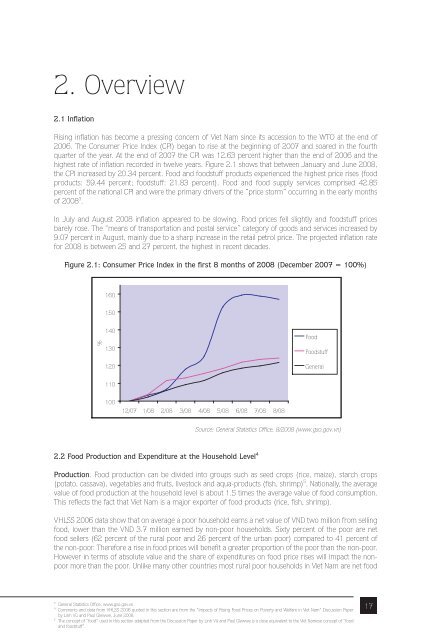Untitled - Oxfam Blogs
Untitled - Oxfam Blogs
Untitled - Oxfam Blogs
Create successful ePaper yourself
Turn your PDF publications into a flip-book with our unique Google optimized e-Paper software.
2. Overview<br />
2.1 Inflation<br />
Rising inflation has become a pressing concern of Viet Nam since its accession to the WTO at the end of<br />
2006. The Consumer Price Index (CPI) began to rise at the beginning of 2007 and soared in the fourth<br />
quarter of the year. At the end of 2007 the CPI was 12.63 percent higher than the end of 2006 and the<br />
highest rate of inflation recorded in twelve years. Figure 2.1 shows that between January and June 2008,<br />
the CPI increased by 20.34 percent. Food and foodstuff products experienced the highest price rises (food<br />
products: 59.44 percent; foodstuff: 21.83 percent). Food and food supply services comprised 42.85<br />
percent of the national CPI and were the primary drivers of the “price storm” occurring in the early months<br />
of 2008 3 .<br />
In July and August 2008 inflation appeared to be slowing. Food prices fell slightly and foodstuff prices<br />
barely rose. The “means of transportation and postal service” category of goods and services increased by<br />
9.07 percent in August, mainly due to a sharp increase in the retail petrol price. The projected inflation rate<br />
for 2008 is between 25 and 27 percent, the highest in recent decades.<br />
Figure 2.1: Consumer Price Index in the first 8 months of 2008 (December 2007 = 100%)<br />
160<br />
150<br />
%<br />
140<br />
130<br />
120<br />
Food<br />
Foodstuff<br />
General<br />
110<br />
100<br />
12/07 1/08 2/08 3/08 4/08 5/08 6/08 7/08 8/08<br />
Source: General Statistics Office, 8/2008 (www.gso.gov.vn)<br />
2.2 Food Production and Expenditure at the Household Level 4<br />
Production. Food production can be divided into groups such as seed crops (rice, maize), starch crops<br />
(potato, cassava), vegetables and fruits, livestock and aqua-products (fish, shrimp) 5 . Nationally, the average<br />
value of food production at the household level is about 1.5 times the average value of food consumption.<br />
This reflects the fact that Viet Nam is a major exporter of food products (rice, fish, shrimp).<br />
VHLSS 2006 data show that on average a poor household earns a net value of VND two million from selling<br />
food, lower than the VND 3.7 million earned by non-poor households. Sixty percent of the poor are net<br />
food sellers (62 percent of the rural poor and 26 percent of the urban poor) compared to 41 percent of<br />
the non-poor. Therefore a rise in food prices will benefit a greater proportion of the poor than the non-poor.<br />
However in terms of absolute value and the share of expenditures on food price rises will impact the nonpoor<br />
more than the poor. Unlike many other countries most rural poor households in Viet Nam are net food<br />
3 General Statistics Office, www.gso.gov.vn<br />
4 Comments and data from VHLSS 2006 quoted in this section are from the “Impacts of Rising Food Prices on Poverty and Welfare in Viet Nam” Discussion Paper<br />
by Linh V and Paul Glewwe, June 2008.<br />
5 The concept of “food” used in this section adapted from the Discussion Paper by Linh V and Paul Glewwe is a close equivalent to the Viet Namese concept of “food<br />
and foodstuff”.<br />
17

















